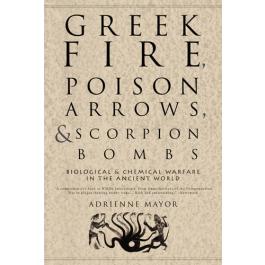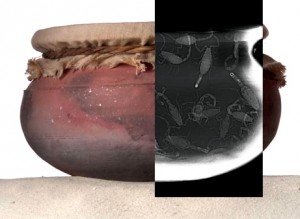by Adrienne Mayor (Wonders & Marvels contributor)
Morbid delight, horror, and melancholy—conflicting moods shaped my research into the amazing arsenal of diabolical biological and chemical weapons that were used in antiquity. Greek Fire, Poison Arrows & Scorpion Bombs: Biological and Chemical Warfare in the Ancient World seems to evoke mixed emotions in readers, too. The sheer number of natural forces that could be weaponized thousands of years before modern technology and scientific biochemical advances is very sobering. Yet it’s difficult to suppress appalled laughter at the images of terrified Romans on siege ladders fending off a rain of clay pots filled with live scorpions, or the horrible last resort of deploying shrieking flaming pigs to send an invader’s war elephants amok.
The enthusiastic responses from readers and the media were gratifying but sometimes disturbing. Countless parents told me that their twelve-year-old boys (and some girls) loved the recipe for making scorpion bombs, the live “grenades” that had saved the ancient desert city of Hatra from the besieging Roman army of Emperor Septimius Severus in AD 198-99. Visions of homemade spin-offs troubled my conscience, imagining kids gleefully lobbing baby-food jars filled with hapless spiders, wasps, fire ants, etc at school bullies. It turned out that grown-ups were just as devilishly attracted to the notion of re-creating ancient biochemical weapons. I had to remind History Channel TV producers, for instance, to don gas masks when they replicated toxic fumes devised by the ancient Spartans.
My study of ancient weapons of mass destruction first came out in 2003, at the start of the Iraq War against Saddam Hussein, ensuring a timely edge. The ruins of Hatra fortress are near modern Mosul, Iraq, where US troops were searching in vain for Saddam’s (nonexistent) weapons of mass destruction. Amid this tension, Newsweek published a sham report announcing that evidence of WMD had been discovered near Mosul—only revealing in the last sentence that the source was actually my account of ancient scorpion grenades.
http://www.thedailybeast.com/newsweek/2003/10/05/wmd-they-re-history.html
The dread scorpion bomb was selected for National Geographic’s special Poison issue, “Twelve Toxic Tales.” (2005). The editors decided to make a historically accurate, real scorpion bomb to illustrate the story of Hatra’s unique biological defense weapon. An expert in ancient pottery created an authentic replica of a terracotta jar found in the ruins of Hatra. After diligent searching they obtained, from an exotic pet shop in Rhode Island, a dozen live Iraqi Death Stalker scorpions, scrabbling about in a plastic takeout container.
Then, in the National Geographic studio, photographer Cary Wolinsky and scorpion wrangler Fred SaintOurs found themselves facing the same dire threat of “blowback,” a perennial dilemma for all who resort to biological weapons, that the defenders of Hatra had somehow overcome.
How does one safely stuff several annoyed and agitated giant scorpions into a jar? In antiquity the common technique was to verrrrrry carefully spit on the business end of the scorpion. But that requires nerves of steel and perfect aim. Resorting to a method unavailable to the ancient desert-dwellers in Iraq, they placed the scorpions in a refrigerator to induce torpor before each photo session. The resulting photograph and X-ray of the replica scorpion bomb of Hatra was a smashing success and one of my favorite souvenirs of this book.
http://ngm.nationalgeographic.com/ngm/0505/feature1/assignment2.html

About the author: Adrienne Mayor, Research Scholar in Classics and History of Science, Stanford, is the author of Greek Fire, Poison Arrows, & Scorpion Bombs: Biological and Chemical Warfare in the Ancient World (rev ed 2009); and The Poison King: The Life and Legend of Mithradates, Rome’s Deadliest Enemy, a National Book Award nonfiction finalist.


